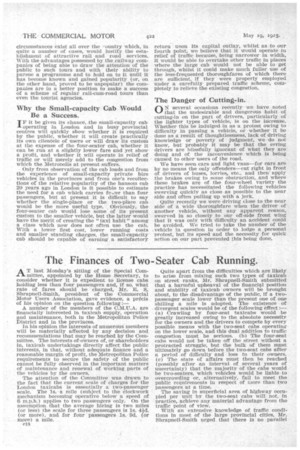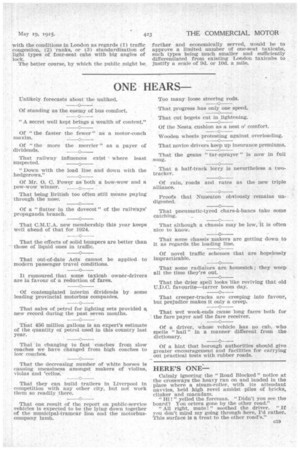The Finances of Two-Seater Cab Running.
Page 2

Page 3

If you've noticed an error in this article please click here to report it so we can fix it.
A T last Monday's sitting of the Special Com mittee, appointed by the Home Secretary, to consider whether it is expedient to license cabs holding less than four passengers and, if so, what rate of fares should be charged, Mr. E. S.. Shrapnell-Smith, president of the Commercial Motor Users Association, gave evidence, a précis of his opinion on the question following :— A number of the members of the C.M.U.A. are financially interested in taxicab supply, operation and maintenance, both in the Metropolitan Police District and in the provinces. in his opinion the interests of numerous members will be materially affected by any decision and recommendations that may be reached by the Committee. The interests of owners of, or shareholders in, taxicab undertakings directly affect the public Interests, in that, without adequate finance and a reasonable margin of profit, the Metropolitan Police requirements to secure the safety of the public cannot be fully observed in the important matters of maintenance and renewal of working parts of the vehicles by the owners. The attention of the Committee was drawn to the fact that the current scale of charges for the London taxicabs is essentially a two-passenger scale. The is.a mile (subject to the clockwork mechanism becoming operative below a speed of 6 m.p.h.) applies to two passengers only. On the assumption that the average hiring is two miles (or less) the scale for three passengers is is. 4id. (or more), and for four passengers is. 9d. (or more) a mile. • el8 Quite apart from the difficulties which are likely to arise from mixing such two types of taxicab on street ranks, Mr. Shrapnell-Smith submitted that a harmful upheaval of the financial position and stability of taxicab owners will be brought about, to the disadvantage of the public, if a twopassenger scale lower than the present one of one shilling a mile is adopted. The existence of divergent scales would be of the following effect :— (a) Crawling by four-seat taxicabs would be greatly increased owing to the absolute necessity for the owners and the drivers to compete by every possible means with the two-seat cabs operating on the lower scale, and this dual addition to traffic congestion must be serious. (b) The four-seat cabs would not be taken off the street without a protracted struggle, but the bulk of them must ultimately go down before the two-seat cabs after a period of difficulty and loss to their owners. (c) The state of affairs must then be reached (possibly after an interval of several years of uncertainty) that the majority of the cabs would be two-seaters, which vehicles would be liable to overcrowding or, alternatively, fail to meet the public requirements in respect of more than two passengers at a time. The saving in superficial area of highway occupied per unit by the two-seat cabs will not, in practice, achieve any material advantage from the traffic point of view. With an extensive knowledge of traffic conditions in most of the large provincial cities, Mr. Shrapnell-Smith urged that there is no parallel with the conditions in London as regards (1) traffic congestion, (2) ranks, or (3) standardization of light types of four-seat cabs with big angles of lock.
The better course, by which the public might be further and economically served, would be to approve a limited number of one-seat taxicabs, such types being much smaller and sufficiently differentiated from existing London taxicabs to justify a scale of 9d. or 10d. a mile.




























